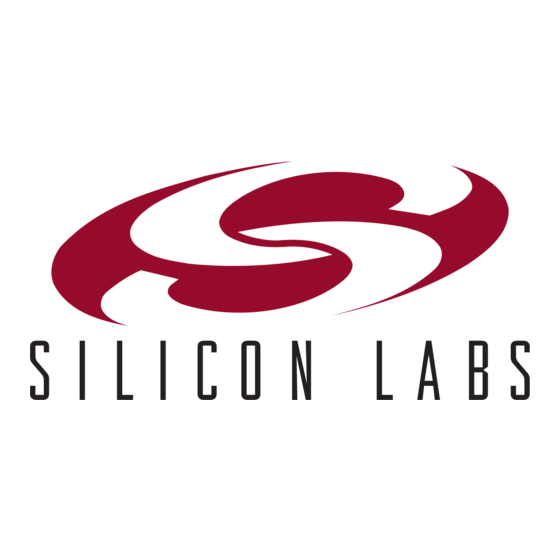
Table of Contents
Advertisement
Quick Links
8-B
USB D
I T
1. Introduction
The 8-bit USB Debug Adapter (UDA) provides the interface between the PC's USB port and the Silicon Labs 8-bit
target device's in-system debug/programming circuitry. The 10-pin ribbon cable connects the adapter to the target
board and the target device's debug interface.
There are two versions of the 8-bit USB Debug Adapter: the original 8-bit adapter is the EC3, and the new 8-bit
debug adapter is UDA-8. The new adapters (UDA-8) are no longer compatible with older versions of Silicon
Laboratories software. Silicon Labs strongly recommends upgrading the software to the latest versions of the
Silicon Laboratories 8-bit IDE and Flash Programming Utilities. The older 8-bit debug adapter, EC3, will be
discontinued September 30th, 2013. Visit
To differentiate between the two adapters, the UDA-8 adapters have a UDA-8 sticker on the bottom. The EC3
adapters will either not have this sticker or have an EC3 sticker.
The UDA-8 debug adapter is compatible with the following tools from Silicon Laboratories.
8-bit IDE Software, version 4.50 and later.
8-bit Flash Programming Utility, version 4.10 and later.
The EC3 will continue to be supported by all versions of the software.
2. Relevant Documentation
Application notes can be found on the 8-bit MCU Application Notes web page: www.silabs.com/appnotes.
AN124: Pin Sharing Techniques for the C2 Interface—Describes in detail the debug interface pin
sharing feature for C2 devices, which enables debugging and use of the /RST and GPIO pins shared with
C2CK and C2D.
AN117: Using C8051Fxxx On-Chip Interface Utilities DLL—The SiUtil DLL discussed in this document
uses the USB Debug Adapter to program the memory space of C2 and JTAG devices.
AN134: Multiple-Device JTAG Configuration in the Silicon Labs IDE—Configuration in the IDE and
using the USB Debug Adapter for devices in a JTAG chain.
Rev. 0.2 6/13
A
E B U G
DAPTER
www.silabs.com/8bit-uda
Figure 1. 8-Bit USB Debug Adapter
Copyright © 2013 by Silicon Laboratories
8-Bit USB Debug Adapter
U
'
G
SER
S
UIDE
for more information.
8-Bit USB Debug Adapter
Advertisement
Table of Contents

Subscribe to Our Youtube Channel
Summary of Contents for Silicon Laboratories DEBUGADPTR1-USB
- Page 1 UDA-8. The new adapters (UDA-8) are no longer compatible with older versions of Silicon Laboratories software. Silicon Labs strongly recommends upgrading the software to the latest versions of the Silicon Laboratories 8-bit IDE and Flash Programming Utilities. The older 8-bit debug adapter, EC3, will be discontinued September 30th, 2013. Visit www.silabs.com/8bit-uda...
- Page 2 3. Pinout Specification The 8-Bit USB Debug Adapter supports both Silicon Laboratories JTAG and C2 debug interfaces, and the adapter is powered from the USB connection to the PC. The UDA is also capable of providing power to the target device or other circuitry via pin 10 of the connector.
- Page 3 (pins 2, 3, or 9). 5. Hardware Setup using a USB Debug Adapter Connect a target board to a PC running the Silicon Laboratories IDE via the USB Debug Adapter as shown in Figure 3. 1. Connect the USB Debug Adapter’s 10-pin ribbon cable to the JTAG or Debug connector on the target board.
- Page 4 The Silicon Laboratories Integrated Development Environment (IDE) along with other software tools are provided for device development and debugging. The IDE is available for download from the Silicon Laboratories website (www.silabs.com/mcudownloads) and is also available on microcontroller development kit CD-ROMs.
- Page 5 8-Bit USB Debug Adapter 8. Schematics Rev. 0.2...
- Page 6 8-Bit USB Debug Adapter Rev. 0.2...
- Page 7 Silicon Laboratories products are not designed, intended, or authorized for use in applications intended to support or sustain life, or for any other application in which the failure of the Silicon Laboratories product could create a situation where per- sonal injury or death may occur.

Need help?
Do you have a question about the DEBUGADPTR1-USB and is the answer not in the manual?
Questions and answers